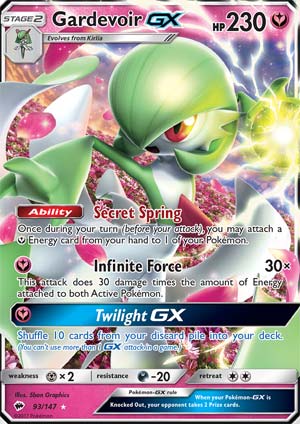
#4 Gardevoir-GX
– Burning Shadows
Date Reviewed:
December 26, 2017
Ratings Summary:
Standard: 3.62
Expanded: 3.60
Limited: 3.92
Ratings are based on a 1 to 5 scale. 1 is horrible. 3 is average. 5 is great.
Reviews Below:
 21times Gardevoir GX (Burning Shadows, 93/147) surprised no one when it came out of the Burning Shadows expansion set and won Worlds. Everyone knew it would dominate, that the card was broken (even got the nickname “Brokenvoir” in London), and it lived up to its billing at first, winning the world championship in the first weekend it was Standard legal over its Burning Shadows counterpart Golisopod GX. However, it started to slip in prominence almost immediately. At Bremen and Hartford, the next Standard tournaments, it placed only one deck in the top eight. It recovered in mid October in Vancouver, winning the tournament and placing 1st, 2nd, and 6th overall and finished second one month later at the EUIC in London, but it really fell hard in Memphis with only one decklist in the top 32 (ninth). Digging just a little deeper into the stats, we find that it actually placed nine decks in the top sixty at Memphis, but considering there was very little Metal (from what I found there were only 25 Metgross decks and 9 Solgaleo decks out of almost a thousand players – there were 143 Gardy decks), I think we were all shocked that it placed only a single deck in the top 32. These results really say to me, “Gardy’s a good deck, but it’s not top tier.” And that’s before we take into account that Ultra Prism has a TON of Metal Pokemon and support in it. From Solgaleo Prism, to Dusk Wing Necrozma, to Magnezone, to Dialga GX, and finally the incredibly frightening Cyrus Prism card, this expansion is STACKED for Metal decks. For us here in America, there is no major Standard tournament until Collinsville, the first day that Ultra Prism is legal. Therefore, sadly, I have to say that Gardevoir GX has fallen from the top tier of the meta and will probably see very little competitive tournament play in the foreseeable future. Rating Standard: 3 out of 5 Conclusion Gardevoir GX got off to an amazing start and won the World Championship. Unfortunately, the game’s designers have decided to bring Gardy’s reign of dominance to an end. It is what it is – this game is always changing. I frequently use the pendulum as an analogy, and the pendulum has now drastically swung out of Gardy’s favor. Could it come back? Absolutely. Could we see a Pokemon with an ability to eliminate Metal weakness for Fairy Pokemon at some point in the future? Sure, I wouldn’t be surprised in the least, and then we can all get our Gardy’s back out. It’d be really funny if something like that occurred in August of 2019 – theoretically the last month for Gardy to be Standard legal. Wouldn’t that be something if Gardy won the very first and last tournaments it would be Standard legal for? |
 Vince Gardevoir-GX makes the list of being the 4th best card of 2017 after being on the list of being the third best card of Burning Shadows. It was a Pokémon that was built to perform well, and this Pokémon has been part of a deck that won Worlds 2017 masters division. And by looking at this card and the review crew’s previous review of Gardevoir-GX, it’s not hard to see why this card still has potential. Gardy’s effect text is the talk of the card. Secret Spring allows you to attach one fairy energy from your hand to one of your Pokemon. This ability stacks, so if you have four of them, then you can attach four more fairy energy cards! This is still good Energy acceleration even though you attach one at a time. What can you do with extra energy attachments? You can fuel up other attackers, or even Gardevoir-GX herself so that Infinite Force does 30 damage times the amount of energy attached to both Active Pokemon. It takes 8 energies and a Choice Band to OHKO any Pokemon. Loading up energies on one Pokemon is double-sided; while you add more pressure to your opponent, the Pokemon is also suspectable of being retaliated back and KOed, losing all the investment you’ve put into. As a GX Pokemon, she also has her GX attack called Twilight, which puts 10 cards from the discard pile to your deck. It could be any card, such as putting 10 items so that Garbodor’s damage output would be pathetic or putting Pokemon and Energy back to the deck. So how is Gardy doing now? Well, she’s still going strong, but now she has to face new rivals in the next set such as Leafeon-GX, Glaceon-GX, Both Necrozma forms, even more metal support to give Gardy a hard time. Probably a small boost she will have is Super Boost Energy Prism Star. That one in a deck special energy grants 4 units of energy of any type if there’s 3 or more of your Stage 2 Pokémon in play. A scary scenario would be to attach Super Boost Energy, attach a Choice Band, and use four Secret Spring abilities. Then you would swing for 270 out of nowhere, and you don’t even have to rely on your opponent’s Active Pokémon having any energies. Standard: 3.5/5 Notes: Don’t let these scores discourage you from using Gardevoir even if metal support from Ultra Prism is too much for her to handle. Her attributes is what made her strong, from energy acceleration ability to an equivalent of Psychic Infinity. Maybe if there was something that can make fairies remove their weakness outside of Weakness Policy? |
 Retro
Probably the most offensive card of this side of the meta table; Gardevoir-GX, the card that banished Dragon types to near unplayability and also other heavy energy attackers out with its self-explanatory attack and combo. The bread and butter of Gardevoir-GX lies in the beautiful combination of its Ability and its main attack. The ability, Secret Spring, allows you to attach any extra basic Fairy energy from your hand to any Pokemon, preferably the active Gardevoir to rain hell. Its attack, Infinite Force, deals 30x the number of energies attached to both Active Pokemon, which is an enhanced copy of Mewtwo-EX (BW NXD)’s X-Ball attack. And with its writing being just energy, not only Special Energy or Basic Energy means that you can actually use any combination of basic and Special energy, preferably Double Colorless Energies to really push the damage output of Gardevoir’s Infinite Force to 180+ levels quite consistently. If any card can reach 180 damage quite comfortably, it is a sure sign that this card is meta. And indeed it has, having scored numerous notable finishes just several months after its release in various iterations. And if any Gardevoir-GX goes down in defeat because of something inevitable and loses all its energies, it has the Twilight GX attack to put back 10 cards from the discard pile to the deck. This is a great late game move with myriads of utility based on the cards put back into the deck. Maybe another shot at that tech Acerola or the 5th Guzma or N to slow down your opponent or to claim the win? Things like that can happen with Twilight GX. As its most standard iteration, with just itself, Gallade (XY BKT) and Octillery (XY BKT) alongside Alolan Vulpix and Diancie (SM BUS) it won the 2017 PTCG World Championship under Diego Cassiraga. In its next iteration, the Gardevoir/Sylveon version (my favorite variant) finished top 4 in the Hartford Regionals under Sam Chen. And more recently, ditching the Sylveons for Alolan Vulpix and 4 Max Potions under the codename “BrokenVoir” finished third in the London Internationals under Christopher Schemanske, showing the strength and adaptability of Gardevoir-GX. However, it faces a very glaring set of problems, ones that really hurt it most of the time. It badly loses against Stage 1 GX decks, preferably against ones with Zoroark-GX (SM SHL) as it is a Stage 2 Pokemon-GX which takes a bit longer to setup and needs more resources to get going. And it also has tendencies to not setup because of continuously whiffing key cards, which can be exploited by chip attacking decks like Buzzwole-GX (SM CRI) and Tapu Koko (SM30)/Espeon-EX. Even when you use the more consistent Sylveon variant, it is extremely susceptible to N, which is bad in a Stage 2 deck because you can end up in a dead hand. Most of my losses happened because I got N-ed down to a set of 6 unplayable hands with no draw supporter cards. It also loves dear its 4 DCEs, so if any of them got discarded out, it can’t retaliate back effectively unless your opponent really fell for the Infinite Force trap. Overall, Gardevoir-GX has its ups and downs, but it shows its strength brightly throughout the year that very few cards can achieve, and for that reason, it still is a popular pick towards many tournaments and casual play. Even with all the new Metal threats coming in, I can see Gardevoir decks choke just a bit and will just adapt again to the meta climate. Rating: Standard: 4.47/5 |
 Otaku Fourth place on our Top 10 of 2017 countdown goes to Gardevoir-GX with appearances on all four individual top 10 lists (including topping one!) and 47 total voting points to its credit. That’s one entire list and 12 voting points more than yesterday’s Choice Band! What makes Gardevoir-GX so great? Unless you’re almost totally unfamiliar with the competitive metagame for the last four months, you already know: Gardevoir-GX established its own deck, and its a deck that has been among (sometimes the) top deck in the Standard Format. This is quite impressive because Gardevoir-GX is a Stage 2 Pokémon, and even with cards like Rare Candy, Stage 2 Pokémon are still slow and resources intensive. At the same time, Gardevoir-GX brings with it many, many advantages, which have been enough to compensate. Normally, I’d prefer to run through the entire card, but I fear that with the length a Stage 2 card – especially a Pokémon-GX – requires, the finer points might become obscured. The big picture is that we’ve got a big, Stage 2 Pokémon-GX that accelerates Energy, hits hard (with enough Energy), and can recycle 10 cards from your discard pile at the cost of its GX-attack. Even with cards like Rare Candy, even with deck space so tight, it seems Gardevoir-GX does better with another Pokémon opening for it, so the deck has slow starts (in terms of raw offense). Like Golisopod-GX, you have to worry that a Gardevoir-GX you don’t OHKO is going to bounce via Acerola, and thanks to its “Fairy Spring” Ability, throw some of the Energy back down on the next Gardevoir-GX. Unless Gardevoir-GX decks learn some new tricks soon, however, it is in for rocky times. Attackers are hitting higher numbers, so 230 HP isn’t as safe as it once was. More attackers that swing for low damage and have the HP to survive a hit from Gardevoir-GX. More support for Gardevoir-GX (and other multi-Stage 2 decks) is on the way, but so are more counters and rivals. Currently, Gardevoir-GX still seems to have solid Standard Format prospects. I don’t recommend taking it to a tournament, but I’m also not telling you that you must absolutely avoid it. I’m much less confident about its performance in the Expanded Format. Gardevoir-GX has enough going for it that it doesn’t automatically crash and burn when Abilities or Items are locked down, but it does hurt the deck… and having to worry about either or both just seems more common in Expanded. Like most Stage 2 Pokémon, it’s awesome when it hits the field in the Limited Format, but pulling at least a 1-1-1 Evolution line and at least filler (if not honest support) can be a challenge. Gardevoir-GX only took sixth place on my personal top 10; it has had a great four or so months, but its future prospects aren’t looking the best and remember, it’s only one deck with relatively minor variations. The five cards I ranked above it are either generalists, staples that appear in nearly everything (often in multiples), loose staples that appear in most things (sometimes in multiples), or strong performers in multiple, distinct decks. Ratings Standard: 3.5/5 Expanded: 3/5 Limited: 3.25/5 |
 aroramage #4 Gardevoir-GX – the deck-to-beat right now, Gardevoir-GX handles being a Stage 2 GX by offsetting itself with not only a great Ability but two 1-Energy cost attacks, one of which can deal out major damage for little investment while the other is a once-per-game mass recovery option. It should be no surprise that Infinite Force is the major highlight here, and while I personally am not a huge fan of the deck, there’s no denying that Gardevoir-GX has a potent position in the game and likely will remain that way for a little while. At least until the next powerful broken Pokemon card comes out. |





